Key takeaways:
- Rate comparison tools simplify the search for the best deals by providing filtering options and transparency, enhancing financial literacy.
- Identifying clear needs and goals helps prioritize essentials over desires, leading to better financial outcomes and avoiding hidden costs.
- Timing purchases strategically and leveraging loyalty programs can result in significant savings, emphasizing the importance of planning in financial decisions.
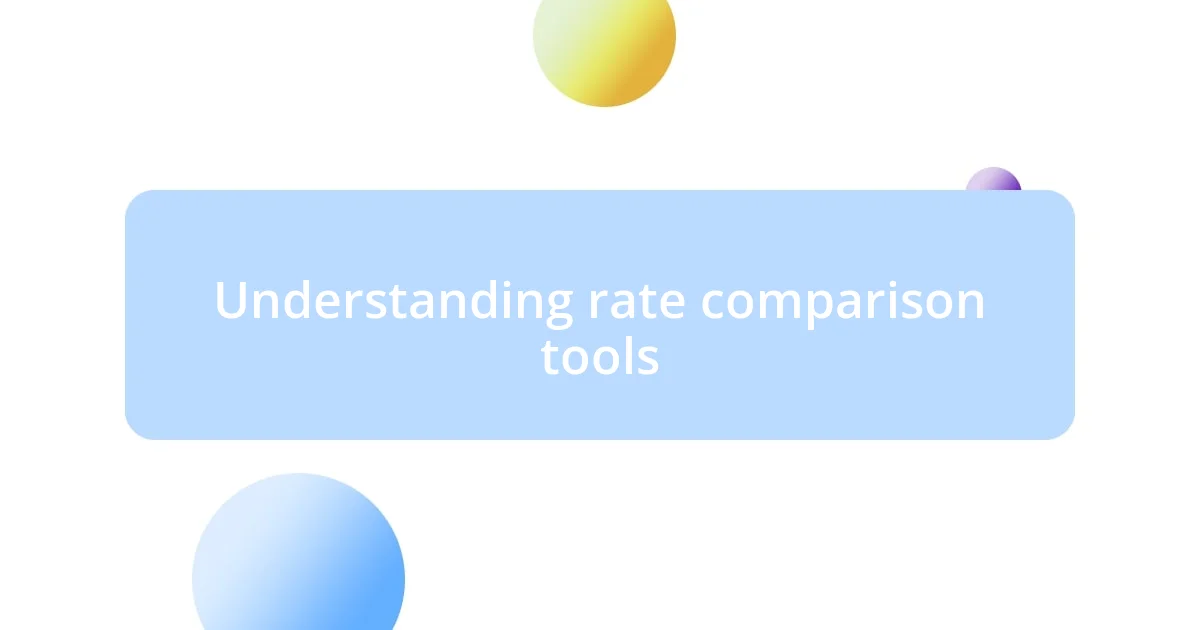
Understanding rate comparison tools
When I first started using rate comparison tools, I was genuinely amazed at how they simplified my search for the best deals. It was almost like being handed a magnifying glass that highlighted all the hidden gems among countless options. Have you ever felt overwhelmed by choices? These tools help cut through the noise, allowing you to focus on what truly matters—like finding the best interest rate on a loan or the most competitive insurance premiums.
One feature that stands out to me is the filtering options. I remember feeling a sense of empowerment as I adjusted parameters to match my specific needs. For instance, when I was in the market for a new car insurance policy, being able to compare coverage levels alongside costs felt like putting together a puzzle tailored just for me. It’s remarkable how these tools not only save time but also help users make informed decisions that align with their financial goals.
Additionally, I appreciate the transparency these tools provide. While navigating through different quotes, I often pause to reflect on the many factors influencing rates—like personal credit scores or vehicle safety ratings. Have you ever considered how much a single change in your profile could impact your rates? Understanding this interplay can be enlightening, and it underscores the importance of using these comparison tools as more than just calculators, but as gateways to financial literacy.

Identifying your needs and goals
Identifying your needs and goals is a pivotal first step in securing the best rates, and I’ve found that the clearer I am about what I want, the better my outcomes. For example, I once went into the search for a mortgage almost blindly, unaware of how crucial my preferences were. It wasn’t until I wrote down my must-haves—like a fixed rate and a certain loan term—that I felt a newfound sense of direction and control over the process.
To truly hone in on your needs, I suggest taking a moment to reflect on your long-term financial objectives. When I was seeking a personal loan a few years back, I realized my priorities extended beyond just securing the lowest interest rate; I wanted flexibility in my payment structure as well. This realization not only helped me narrow down my options but also allowed me to articulate my needs clearly to lenders, ultimately leading to a better deal.
Here’s a little contrast between prioritizing needs versus desires. When my friend sought a credit card, he focused more on rewards versus the overall interest rates and potential fees. The differences in our approaches highlighted just how important it is to clarify what truly matters. I remember seeing him frustrated when he learned about hidden costs, which reinforced my belief that distinguishing needs from wants can save both time and money.
| Prioritizing Needs | Focusing on Desires |
|---|---|
| Clear financial objectives | Emphasis on perks |
| Leads to better deals | Potential hidden fees |
| Informs lenders of specific criteria | May result in missed opportunities |

Researching available options
Researching available options is a bit of an art form that I’ve come to appreciate. I’ll never forget the time I stumbled across an online forum dedicated to financial advice. It was like discovering a treasure trove of insights where everyday people shared their experiences on various rates—like finding golden pieces of advice while sifting through a sea of information. Seeing others discuss their successes and challenges helped guide my own research.
Here are some effective strategies I’ve used to streamline my search:
- Use Multiple Comparison Tools: Each platform may offer different deals, so I like to check a few to broaden my perspective.
- Read Reviews: I often dig into consumer feedback for a more personal take on the service or rates offered.
- Join Online Communities: These groups can provide invaluable insights and tips based on collective experiences.
- Sign Up for Alerts: I find that setting up notifications for rate changes ensures I’m always in the loop when good deals arise.
When I was keen on refinancing my student loans, I spent hours sifting through various lenders’ websites. It was exhausting! The thing that stood out to me was how much personal reconciliation I needed to do with my financial situation as I compared options. I felt a mix of anxiety and anticipation—for every rate I came across, there was the possibility of saving money, but also the pressure of making the right choice. Balancing that excitement while meticulously gathering pertinent details helped me refine my options effectively. Ultimately, my efforts paid off, as I secured a much lower rate than I initially thought possible.
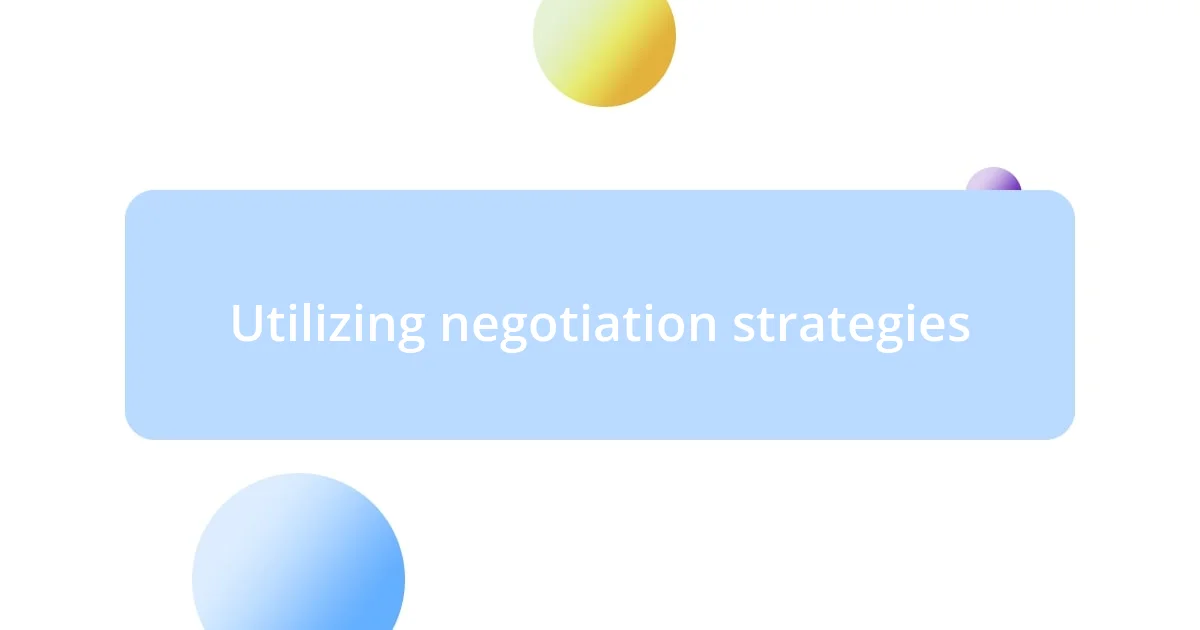
Utilizing negotiation strategies
Using negotiation strategies can be a game changer when looking for the best rates. I remember when I was shopping around for car insurance. I had a specific rate in mind, but instead of just settling for quotes, I decided to negotiate. I called my preferred insurer and mentioned competing offers I received. To my surprise, they were able to match one of those rates while also adding additional coverage. It’s incredible how just a bit of confidence and clear communication can alter the outcome dramatically.
One thing I’ve learned is the importance of preparation before entering negotiations. I always take time to gather as much information as possible. Before trying to lower my current credit card interest rates, I made a spreadsheet of my spending patterns and payments. Armed with that data, I approached my bank. I calmly presented my case, emphasizing my value as a long-term customer and how I was actively managing my finances. It felt empowering to advocate for myself like that, and in the end, they agreed to lower my rate.
Don’t underestimate the power of asking questions during negotiations! When I was looking to refinance my home, I made it a point to ask lenders about any potential hidden fees or penalties. It was surprising how some lenders were eager to provide answers while others became evasive—this helped me sieve through the offers. In fact, I often wonder how many potential deals go awry simply because people feel hesitant to speak up. In my experience, confidence in negotiation not only secures better rates, but also fosters trust and transparency with lenders.
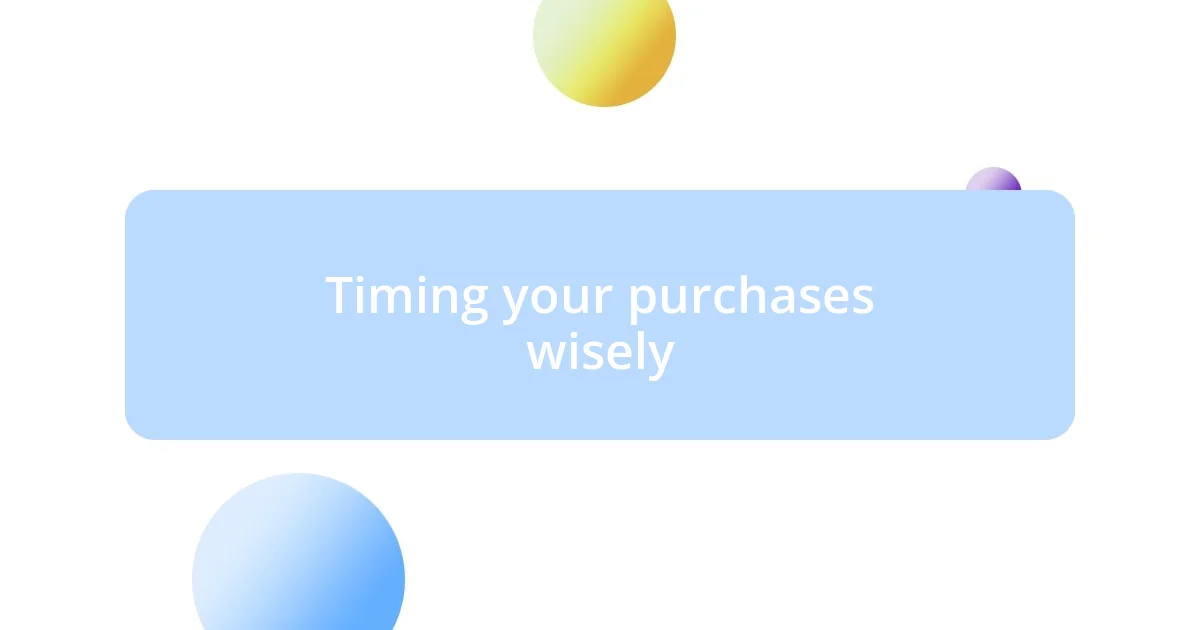
Timing your purchases wisely
Timing really is everything when it comes to making smart purchases. I vividly recall the thrill of waiting for holiday sales to buy new electronics. I had my eye on a particular laptop, and by keeping track of release dates and price drops, I managed to snag it at nearly half the price. This experience taught me that being patient can lead to significant savings; sometimes, the best deals require just a bit of waiting.
Seasonal trends can also dramatically impact prices. For instance, the last time I bought a winter coat, I strategically waited until February, long after the holidays had passed. It turned out to be one of my best financial decisions. Retailers often discount items to clear out inventory after the peak season, and I was able to score a high-quality piece for a fraction of its original price. This approach required me to predict the cycle of demand, but the payoff was rewarding.
Don’t forget the power of timing tied to specific events. I once planned a vacation during the off-peak season and was amazed at how much money I saved on flights and accommodations. It got me thinking—how many people miss out on great rates simply because they book without considering the timing? I realized that shifting my purchasing calendar by just a few weeks can lead to extraordinary savings, making it an essential strategy in my financial toolkit.
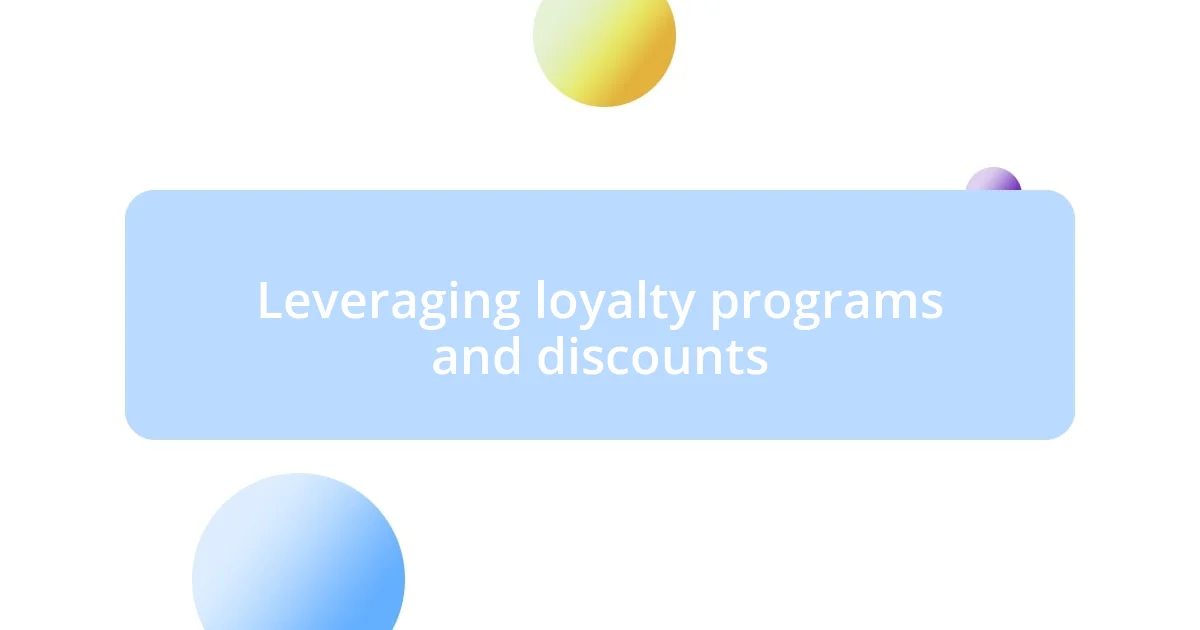
Leveraging loyalty programs and discounts
I’ve found that loyalty programs can be this hidden gem when hunting for the best rates. For example, I signed up for a hotel chain’s loyalty program, and when I booked my last vacation, I was pleasantly surprised to discover that my points covered a significant portion of my stay. It’s like receiving a little thank-you gift for being a loyal customer—but you have to take advantage of it! Doesn’t it feel great to get reward bonuses for something you were already planning to do?
Discounts, whether through memberships or seasonal sales, have also played a huge role in my budgeting. I once bought a high-end kitchen appliance using my store’s loyalty card during a double points event. Combining that with a promotional discount meant I saved a staggering amount—enough to buy a few other items I needed. Have you ever felt that rush of excitement when you see the final price drop right before your eyes? It’s truly satisfying.
Don’t forget to check for discounts before making any purchases, whether it’s a small item or a big investment. I always browse for promo codes online before checking out, and it has saved me a couple hundred bucks over the years! Sometimes, those codes are just sitting out there, waiting for someone like you or me to find them. Why not seize the opportunity if they’re available? It’s this sort of proactive attitude that can really transform your spending habits.
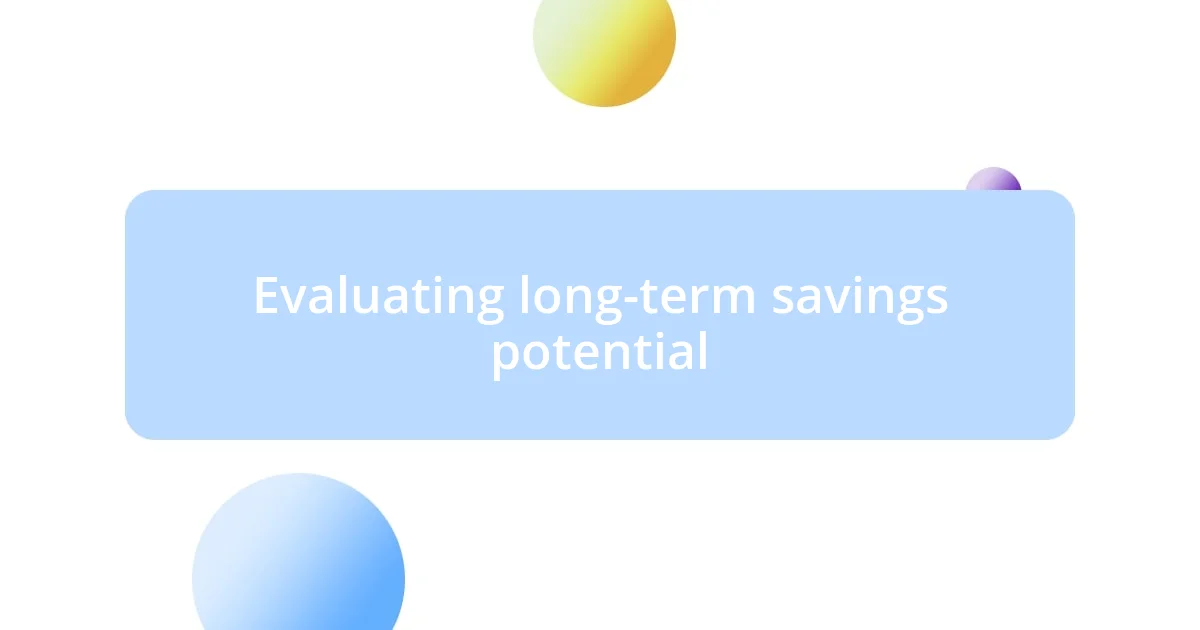
Evaluating long-term savings potential
Evaluating long-term savings potential involves looking beyond immediate costs. I remember when I was deciding whether to invest in energy-efficient appliances. At first, the upfront price felt steep, but after calculating my expected savings on utilities over several years, it was clear that the initial investment would pay off significantly. Have you ever considered turning that seemingly high purchase into a smart long-term decision?
It’s essential to project savings into the future. For a personal example, I calculated the long-term benefits of switching to a high-interest savings account. Sure, traditional accounts offered minimal returns, but by making the switch, I was able to grow my savings exponentially over time. This shift reshaped my financial outlook; it’s fascinating how a seemingly small change today can lead to big rewards tomorrow, isn’t it?
When analyzing potential long-term savings, I always ask myself: “What will this cost me over the next five years?” This mindset has influenced everything from my choice of a car to my investment in home improvements. One project I undertook was adding insulation to my attic; while it involved an upfront expenditure, I quickly saw a dip in my energy bills. It’s moments like these that remind me—some of the best financial decisions stem from looking past the present and visualizing future gains.














